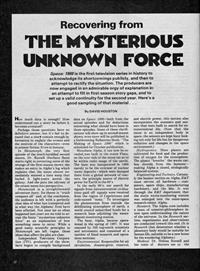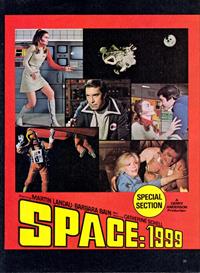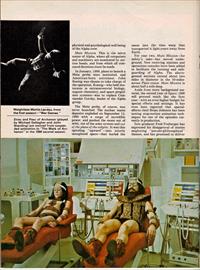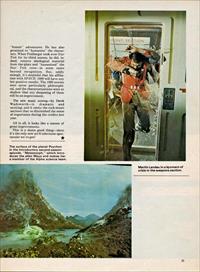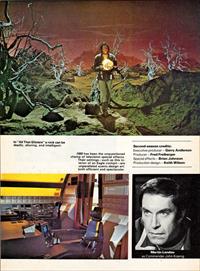Criticism
Recovering from The Mysterious Unknown Force
by David Houston
Starlog Number 2 (Nov 1976) p32-35
The article followed up Houston's article in the previous issue of Starlog. The title "Mysterious Unknown Force" was to become a popular term both for critics and fans (see the article by David Hirsch). The original ITC publicity material that Houston summarised is in the Catacombs. The information about Moonbase Alpha is garbage, created with no reference to the series, or to scientific veracity. This article was followed by an episode guide.
Space: 1999 is the first television series in history to acknowledge its shortcomings publicly, and then to attempt to rectify the situation. The producers are now engaged in an admirable orgy of explanation in an attempt to fill in first-season story gaps, and to set up a valid continuity for the second year. Here's a good sampling of that material ...
How much data is enough? How understated can a story be before it becomes Unstated?
Perhaps those questions have no definitive answer, but it's fair to demand that a story contain enough information to explain the events and the motives of the characters- even in science fiction. Even in fantasy.
In Metamorph, the very first episode of the much-heralded second season, Dr. Russell (Barbara Bain) starts right in correcting some of the wrongs of the first-season shows: she makes an entry in Alpha's log which explains that the moon almost immediately entered a time warp that hurled it light-years across the galaxy. And she puts the odyssey of the errant moon into perspective.
Metamorph is a straightforward adventure story. Its theme is "truth conquers all" and, at the conclusion, the audience is left with a perfectly clear idea of what has transpired and in what way the Alphans' lives have been affected. Not once (as so often happened last year) are we told to accept the fuzzy "mysterious unknown force" as an explanation of how something came to occur. While a good many scientific principles in Metamorph are left vague, those ideas that affect the plot are clear.
Independent Television Corporation (ITC), producers of the show, have begun to compile background data on Space: 1999- both from the actual episodes and for deductions concerning what should have been in those episodes. Some of these clarifications will show up in second-season shows; even more will be published in a forthcoming Ballantine Book: "The Making of Space: 1999" which is scheduled for October publication.
Moonbase Alpha, it can now be revealed, was built in the crater Plato, on the near side of the moon (so as to be within radio range of the Earth). The base was inaugurated in 1988 merely to be the overseer of nuclear waste deposits- which were dumped there from a global network of reactors, the principle source of electric power for Earth in the 1980s.
In the early 1990s, our search for signals from extraterrestrial civilizations paid off: signals were received from the region of Capricornus and code-named "meta." To investigate the phenomenon from outside the debilitating atmosphere of Earth, a world council subscribed funds for a research base adjoining the waste-deposit monitoring station.
The base, Alpha, became operational in the spring of 1997. It was manned by 330 top-notch scientists and astronauts and consisted of a number of fixed research and operations sections:
ENVIRONMENTAL. Responsible for air circulation, disease-germ removal, and electric power, this section also incorporates the scanners and sensors that were built to search for extraterrestrial life. (Now that the moon is an independent body in space, the sensors are kept busy looking not only for life but for dangerous radiation and changes in the space environment.)
HYDROPONICS. Here plants are cultivated for food and the production of oxygen for the atmosphere. The plants "breathe" the waste carbon dioxide from the humans- making Alpha a closed, ecologically balanced system.
ENGINEERING AND TECHNICS. Certainly the busiest section on Alpha, E&T must service all hardware- computers, space ships, manufacturing machinery, and the like. It was through the E&T department that the static waste-monitoring station was enlarged into the outer-space research center, Alpha.
RESEARCH. The Alpha crew includes a team of scientist-philosophers intent upon understanding the nature of the universe. In the Research section, experiments and observations are conducted toward this end. (It is Research that determines whether a planetary body would be suitable for human life, suitable to be a new home for the wandering Alphans.)
MEDICAL. Dr. Helena Russell and her team of doctors see to the physical and psychological well-being of the Alpha crew.
MAIN MISSION. This is the nerve center of Alpha, where all computers and machinery are monitored by section heads, and from which all command decisions must be made.
In January, 1999, plans to launch a Meta probe were instituted, and American-born astronaut John Koenig was chosen to take charge of the operation. Koenig- who held doctorates in extraterrestrial biology, organic chemistry, and space propulsion systems- was to replace Commander Gorsky, leader of the Alpha group.
The Meta probe, of course, was never launched. The nuclear waste deposits exploded on September 13, 1999 with a surge of incredible power, and pushed the moon out of orbit, out of the solar system, and out of the plane of the ecliptic. It was this spiraling "upward"- into utterly unexplored space- that hurled the moon into the time warp that transported it light-years away from Earth.
For year two, Main Mission- for safety's sake- has moved underground. New receiving stations and operations consoles have been added to facilitate the running and safeguarding of Alpha. The above-ground sections extend about two miles in diameter in the 50-miles-across Plato crater. Main Mission is about a half mile deep.
Aside from story background material, the second year of Space: 1999 will proceed much like the first year- with an even higher budget for special effects and settings. It has even been reported that special effects chief Brian Johnson has been testing stop-motion animation techniques for one of the episodes currently in production.
New producer Fred Freiberger has expressed his disapproval of stories employing "pseudo-philosophical" themes, and has promised to deliver "honest" adventures. He has also promised to humanize" the characters. When Freiberger took over Star Trek for its third season, he did, indeed remove ideological material from the plots and "humanized" the Star Trek crew- in some cases beyond recognition. But, oddly enough, it's doubtful that his affiliation with Space: 1999 will have any but positive results. The 1999 stories were never particularly philosophical, and the characterizations were so shallow that ANY deepening of them will be an improvement.
The new music scoring - by Barry Gray and Vic Elms - is dramatic and exciting; and it omits the rock-music sections that so diminished the sense of importance during the credits last year. (Actually the new music was by Derek Wadsworth)
All in all, it looks like a season of great improvements.
This is a damn good thing- since it's the only new sci-fi television spectacular we've got!
